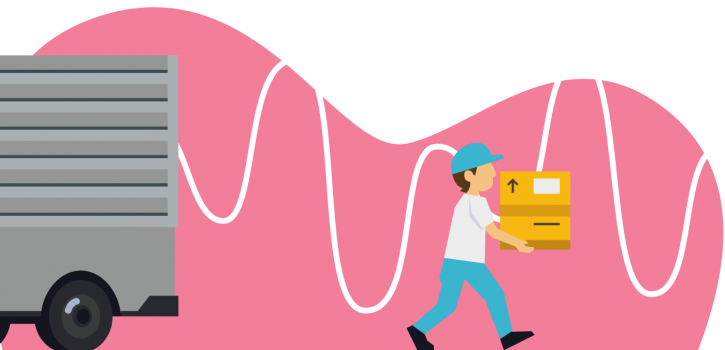Logistics (also known as e-logistics in e-commerce circles) is a cornerstone of electronic commerce that aims to cover all stages of the process. It’s one of the main areas of growth for those working in online sales. Given today’s increasingly demanding consumers, online sellers would do well to stay up-to-date with new issues in digital commerce. Here, we summarise a few key elements that will help you optimise your international logistics and make cross-border e-commerce a powerful catalyst that drives business growth!
Understand the logistics chain to optimise your margins
Improving the entire logistics chain (purchasing, manufacturing, distribution and sales) can pay dividends. The better your logistics systems, the more online sales you will make, and the more purchases will be made on the internet rather than in-store. You can cut costs and improve your margins using a well-designed logistics strategy and following best practices. If you want to understand and optimise your logistics chain, there are certain things you must do.
Check market standards
Before throwing yourself into cross-border commerce, you should know a few different facts:
- Online sellers should have a proven strategy in their established markets before going international.
- They must be able to provide good customer service, sticking to agreed preparation and delivery times. To do this, there are various factors to consider:
- Stock rotation (a shortage can mean losing revenue)
- Having good operators
- Product integration times: for adding to stock and IT systems, etc.
- Stock reliability (avoid errors)
- Product returns
- Product delivery
Amazon has set the bar for logistics in the e-commerce sector by developing these market standards.
Understand local customer needs
Online buyers are gradually starting to trust online sellers more and shopping online is becoming more common, so it’s important not to disappoint your users when it comes to logistics!
You need to anticipate customer demands and meet their requirements. Because consumers are increasingly demanding about logistics, especially delivery times and methods, you must stick to the delivery policy they are shown when buying. Policies can and should vary depending on the market. For example, German consumers appreciate free returns as they are used to ordering clothes in several sizes and sending back any that don’t fit.
Good logistics will help keep your customers loyal and boost efficiency. Did you know that 90% of parcel tracking emails are actually opened by customers? By making emails automatic, you will save time but still keep in touch with your consumers.
Be aware of specific legislation in different countries
Every country has its own import legislation. Customs and excise duties can slow the progress of your shipments and jeopardise smooth delivery. Make sure you find out what you need to know, then tailor your logistics strategy accordingly. “For example, in Switzerland all deliveries (any size) have to be sent with an administration document, or they won’t get past the border,” says Christophe Poutiers, Supply Chain Director at BazarChic.
Set out an effective logistics strategy
The first thing you need to consider before setting out your strategy is which type of logistics is right for your business sector. This may be obvious, but logistics can vary by sector. There are various things to think about before you begin.
Customer retention strategy
Two key elements that make e-commerce sites stand out from the crowd are being able to deliver quickly and at low cost. Indeed, delivery charges and times are the number one purchase criterion for around 72% of online buyers. This comes in way ahead of price (37%). Most sector leaders, such as Cdiscount and Amazon, offer a subscription service providing free, unlimited deliveries in a bid to keep customers loyal.
Delivery methods
Besides some existing delivery time issues, distributors are trying to improve things by offering a varied delivery service with a more personalised approach to better meet consumer needs. Different delivery types include:
- Home delivery: this is online buyers’ favourite method and was chosen around 88% of the time in 2017.
- Parcel lockers: this accessible method is increasingly common and means recipients can be more independent. Lockers can be found in various high-traffic areas, such as train stations and shopping centres.
- Pick-up points: parcels are delivered to a store near the recipient. Consumers like this method. It’s affordable and gives them longer to go and collect their items.
- Click and collect: with this sales method, customers can go online to reserve products available in store. This makes it exclusive to online sellers who also have a brick-and-mortar store. This method is great for consumers as it’s free!
For some delivery methods, businesses can call on specialist services from companies such as Delivengo (an international shipping provider specialising in small parcels) and the logistics provider SupplyWeb.
Learn how to go about international expansion with our guide to online cross-border sales in Europe
Automated logistics hubs
With an automated logistics hub, you can stave off hiring issues, make your work easier, cope with limited space and speed up logistics flows. However, you need to be ready for some issues: it’s difficult to change how an automated system works, which can affect the flexibility sometimes required in logistics. This type of logistics hub is also more expensive than simpler ones. For these reasons, it’s important to think carefully before going automated.
The Amazon approach
With a turnover of more than 170 billion dollars in 2018, e-commerce is Amazon’s flagship sector and something for which the company is famous worldwide. Amazon sets the bar for market standards when it comes to logistics. Launched in 1995 as an unremarkable online bookshop, the platform now offers seemingly infinite products and over 300 million users log in each month.
This e-commerce behemoth is a logistics giant. To save on delivery costs (275 billion dollars in 2018), Amazon has automated most of the work that goes on at its depots. Its subsidiary Amazon Robotics (acquired in 2012 for 775 million dollars) makes conveyor robots and Amazon had 100,000 of these worldwide in 2017.
You need to think carefully about every single aspect of your logistics strategy. Selling in your home country alone will not give you the tools to understand everything you need to about logistics and go international. There are three main steps to take:
- Set out your logistics strategy covering everything from purchasing to distribution and delivery.
- Understand your customers’ needs in each market: is what you are offering right for local consumers?
- Call on specialists and/or local partners who can advise and help you put the best strategy in place for each market.
Now that you have everything you need to come up with an effective international logistics strategy, it’s time to get to it!







